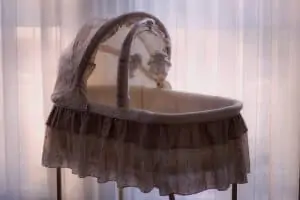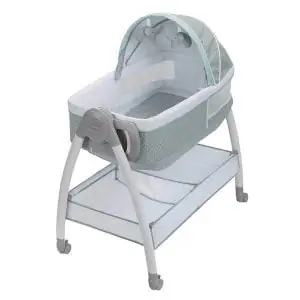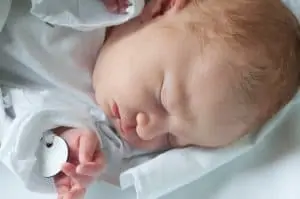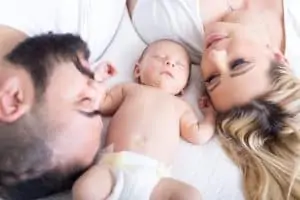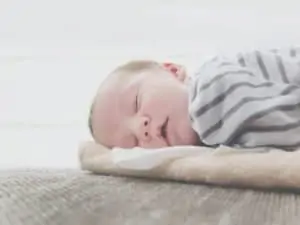Are you trying to decide between a bassinet or a crib and wondering if a bassinet is safe for your baby?
Bassinets are a fantastic option for parents because they allow you to keep your baby closer in the middle of the night. They’re also portable and create a cozier environment for babies. At the same time, they do have some hazards, just like any other sleeping situation.
Here is what you need to know about the safety of bassinets.
Why Should Parents Consider a Bassinet?
Are you tossing between getting bassinets or not? If so, here are some reasons why they might be an excellent choice for you.
Relative: Tips if your baby hates sleeping in a bassinet.
You Can Keep Your Baby Close
It can be strange for both of you to be apart, and it’s natural to want to be close to your baby at all times. That’s maternal instincts working. So, using bassinets keeps your baby close at night. Some types of bassinets attach to the side of your bed, putting your newborn baby on a separate yet level surface as you.
It does help your baby sleep. They can smell and hear you’re breathing, and that encourages your baby to fall into a deeper sleep.
They’re Portable
Many bassinets are portable with wheels attached. So, you can use it in different rooms of the house as needed (or move it to dad’s side of the bed for some extra sleep). This increases the versatility of the bassinet and gives it an even bigger purpose in your house.
It Makes Middle of the Night Feeding Easier
How easy is feeding your baby when he is beside you? If you’re breastfeeding, you need to pick your baby up. If you’re bottle-feeding, try preparing some bottles ahead of time or leaving the supplies in your room to make one quickly.
Room Sharing Reduces SIDS
Last but not least, room sharing reduces SIDS. The American Academy of Pediatrics recommends parents room-share for the first six months to one year to reduce the risk of SIDS.
6 Bassinet Safety Rules
There are some safety rules that you need to know to be sure that your newborn is safe, but most of these are common sense. Following these rules helps keep any harm from happening to your baby, particularly Sudden Infant Death Syndrome.
Here are some safety sleeping rules. 😀
Follow The Safety Standards
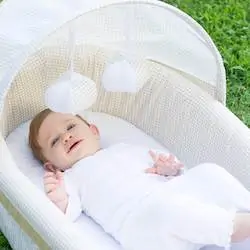
Make sure the bassinet that you pick meets all current safety standards. So that means your family bassinet that has been handed down for years won’t meet standards.
However, I know we all want to hand me downs because they save us money, which is so important. If that’s your case, be sure you take a close look at the bassinet. Is it too soft? Are the sides puffy? Does it feel sturdy?
Also, clean or wash the bassinet at least once a month.
Make Sure The Bassinet Has Mesh
Mesh walls are an absolute must-have for all parents when they select a bassinet. They can save your baby’s life, and that’s not an exaggeration.
Mesh is a must-have because it offers the airflow that is so needed. If your baby rolls over into the side of their bassinet, the breathable mesh ensures that your child doesn’t suffocate, but if the sides are thick cloth, it’s possible.
Also, mesh walls mean you can always visually check on your child. It makes it easier to reassure yourself in the middle of the night that your baby is okay.
Lock Wheels
Most bassinets are portable because it’s a significant selling point for parents. That doesn’t mean they NEED to move just because they can do so.
Make sure you don’t move the bassinet around with your baby inside of it. Another critical safety rule is to be sure you frequently check the wheels to be sure that they’re locked. Checking that all wheels are locked is a way to stop disasters, such as a well-meaning toddler who thinks the bassinet needs to go down the steps.
Scary, right? 😮 Check those locks!
Keep The Bassinet Bare
You always need to make sure that the bassinet is bare. Don’t place objects inside a bassinet or crib because it increases the risk of suffocation and choking. So that means you need to say no to toys, pillows, blankets, and anything else.
Doing this was a substantial contributing factor to the reduction of SIDS.
If you’re worried about your baby getting cold, a safe choice is to use a warm sleep sack or swaddle your baby. Both of these are safe and come without the risks associated with objects in bassinets.
Use Sheets Meant for the Bassinet
Fitted sheets ARE safe for bassinets, but only if you use a sheet that is meant for the bassinet you purchased. Regular crib sheets will be way too large. Instead, look for sheets that fit the dimension of your bassinet.
Make sure the sheets are pulled taut and firm over the mattress.
Don’t Switch to a Softer Mattress
It’s not safe to use a softer mattress in your bassinet.
You might be surprised to see the firmness of a bassinet mattress, but it’s firm because it’s best for your baby’s safety. A softer mattress increases the likelihood of SIDS.
Watch for Recalls
This is important:
Baby gear has recalls all of the time, and that can be frustrating for parents. In 2013, there were some requirement changes for bassinets, which helped to improve bassinet construction to reduce deaths.
If there is an incident with a bassinet, CPSC reacts by launching an investigation into the safety of that bassinet. A recall can occur if it doesn’t mean the right standards.
You should check for recent recalls making sure you aren’t using a lousy product. It’s always better to be safe than sorry.
One simple trick is to sign up for emails from either parenting websites or the bassinet manufacturer. They send out information when a recall takes place.
Are Vibrating Bassinets Safe?
Yes! You can use vibrating bassinets; the gentle vibrations don’t harm your child.
The problem comes if you try to use an inclined, vibrating bassinet. The biggest example is the recently recalled Rock ‘N Play, which caused a massive controversy in the parenting world. The vibration wasn’t the problem; the issue was the incline.
So, if you find a safe bassinet that also offers gentle vibrations to help your baby to sleep, go for it if you think it will help your baby sleep better!
When Should I Move My Baby to a Crib?
The best time to move your baby to a crib is between four and six months old, but some bassinets say that your baby needs to stop using it when they roll over. If that’s what your bassinet’s safety manual states, you need to remove your child between 8-12 weeks or whenever your baby rolls for the first time.
Final Thoughts
If you’re worried about whether or not bassinets are safe, stop worrying! Bassinets are safe if you follow proper safety regulations and rules, but the same thing can be said about cribs. Parents need to follow safety rules in cribs as well, so feel free to keep your baby close to you at night and use a bassinet.
Hey, this is Linda. My biggest accomplishment in life is being a mother of four children. Their current ages range from almost ten years old down to 20 months old.
I’m passionate about writing parenting articles because I understand so well all of the problems and trials you face as a parent. From breastfeeding woes to budgeting problems and behavior problems, along with everything in between, chances are I’ve faced it over the last ten years. Read more about Linda here.


